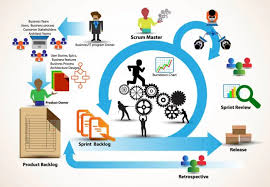The Agile Model in Software Development
Agile methodology is a popular approach in software development that emphasizes flexibility, collaboration, and rapid iterations. Unlike traditional waterfall models, where the entire project is planned upfront, agile development breaks the project into smaller increments known as sprints.
One of the key principles of agile development is the ability to adapt to changing requirements throughout the project. This allows for greater flexibility and responsiveness to customer needs. Agile teams work closely together, often in daily stand-up meetings, to ensure everyone is on the same page and any roadblocks are addressed promptly.
Another important aspect of agile development is the focus on delivering working software quickly and frequently. By breaking the project into smaller chunks and delivering usable features at the end of each sprint, stakeholders can provide feedback early on and course-correct if needed.
Continuous improvement is also a core tenet of agile methodology. After each sprint, teams conduct retrospectives to reflect on what went well and what could be improved. This allows for ongoing refinement of processes and practices to ensure continuous delivery of high-quality software.
In conclusion, the agile model in software development offers many benefits, including increased flexibility, collaboration, and responsiveness to change. By embracing agility and iterative development practices, teams can deliver value to customers more efficiently and effectively.
6 Essential Tips for Mastering Agile Software Development
- Break down the project into smaller tasks or user stories for better manageability.
- Prioritize tasks based on business value to deliver important features first.
- Embrace changes in requirements throughout the development process.
- Encourage collaboration and communication among team members for better outcomes.
- Regularly review and reflect on the team’s progress to identify areas of improvement.
- Iterate quickly and frequently to gather feedback and make necessary adjustments.
Break down the project into smaller tasks or user stories for better manageability.
Breaking down the project into smaller tasks or user stories is a valuable tip in agile software development as it enhances manageability and efficiency. By dividing the project into more manageable components, teams can focus on completing one task at a time, leading to clearer progress tracking and quicker feedback loops. This approach also allows for better prioritization of work and helps in identifying potential bottlenecks early on. Overall, breaking down the project into smaller tasks or user stories promotes a more organized and structured development process, ultimately leading to successful project delivery.
Prioritize tasks based on business value to deliver important features first.
In the Agile model of software development, it is crucial to prioritize tasks based on business value to ensure that important features are delivered first. By focusing on delivering high-value features early in the project, teams can maximize the impact of their work and address critical business needs upfront. This approach not only helps in meeting customer requirements effectively but also allows for quick feedback and adjustments, ultimately leading to a more successful and customer-centric product development process.
Embrace changes in requirements throughout the development process.
Embracing changes in requirements throughout the development process is a fundamental principle of the agile model in software development. By remaining open to evolving needs and priorities, teams can adapt quickly and effectively to deliver solutions that better meet the customer’s expectations. This flexibility not only allows for continuous improvement but also fosters a collaborative environment where feedback is welcomed and integrated seamlessly, ultimately leading to the successful delivery of high-quality software products.
Encourage collaboration and communication among team members for better outcomes.
Encouraging collaboration and communication among team members is a crucial tip in the agile model of software development. By fostering an environment where team members openly share ideas, feedback, and concerns, projects can benefit from diverse perspectives and innovative solutions. Effective communication ensures that everyone is aligned on project goals and priorities, leading to better coordination and ultimately improved outcomes. When team members collaborate effectively, they can leverage each other’s strengths, address challenges collectively, and deliver high-quality software that meets customer needs efficiently.
Regularly review and reflect on the team’s progress to identify areas of improvement.
Regularly reviewing and reflecting on the team’s progress is a crucial practice in agile software development. By taking the time to assess how the team is performing, it becomes easier to identify areas that may need improvement. This reflective process allows team members to celebrate successes, learn from mistakes, and make necessary adjustments to enhance overall performance. Continuous evaluation and feedback help teams stay on track, adapt to changing requirements, and ultimately deliver high-quality software efficiently.
Iterate quickly and frequently to gather feedback and make necessary adjustments.
Iterating quickly and frequently in the agile model of software development is crucial for gathering valuable feedback and making necessary adjustments throughout the project. By breaking down the development process into smaller increments and delivering working software at the end of each iteration, teams can solicit input from stakeholders early on and incorporate changes promptly. This iterative approach not only ensures that the final product meets customer requirements but also allows for continuous improvement based on real-time feedback, ultimately leading to a more successful and user-centric outcome.



